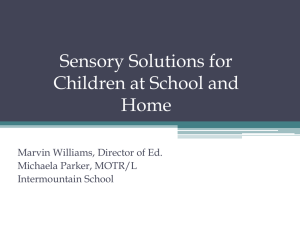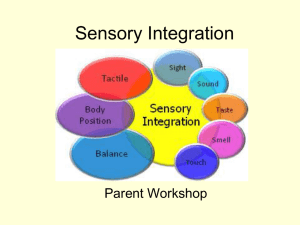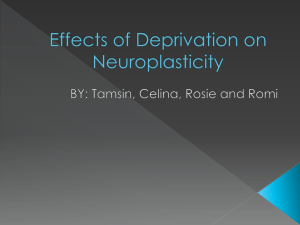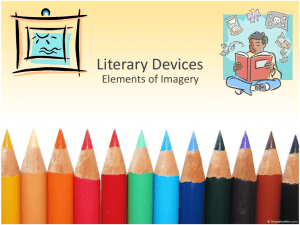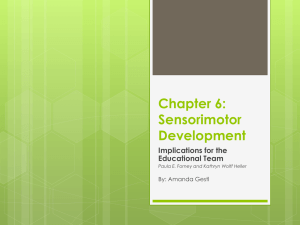Sandy Burbach 2012 Talk
advertisement
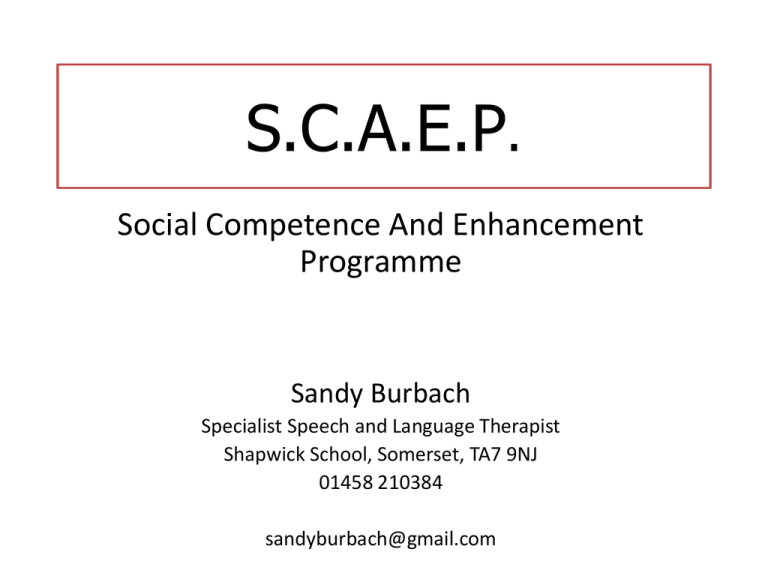
S.C.A.E.P. Social Competence And Enhancement Programme Sandy Burbach Specialist Speech and Language Therapist Shapwick School, Somerset, TA7 9NJ 01458 210384 sandyburbach@gmail.com RATIONALE The key features of the SCAEP programme are an attempt (in progress!) to design a multidisciplinary intervention which serves three purposes: • 1) Taking students back through the sensory building blocks of basic social communication concepts and shared attention to key sensory characteristics; • 2) The development of sensory and language correlates (shared code) needed to describe participants’ experiences of (mis)communication and to develop verbal problem- solving strategies, resilience, emotional intelligence and an understanding of chain reactions; • 3) The development of Internal Language for self- regulation, comparison, prediction, inference and extrapolation. • 4) The core language and sensory building blocks to understand analogy and metaphor, allowing students to compare how a situation appears to them and someone else, and improving our students` potential use of talking therapies e.g. CBT, family therapy etc. Burbach 16/06/2012 2 SOCIAL COMPETENCE • Is a LONG TERM GOAL. • As a result of continuous learning processes through all stages of life. • Measured as an individual`s ability to adapt their own responses and actions to achieve the best possible outcome in any social context. • Individual competence varies across contexts. • Dependent on INTRAPERSONAL and EXTRAPERSONAL factors. Burbach 16/06/2012 3 DEVELOPING RELATIONSHIPS PERSONAL IDENTITY APPROPRIATE APPEARANCE ACQUISITION OF SOCIAL SKILLS CONFIDENCE EXPRESSION OF FEELINGS SELF- ESTEEM GOOD AND BAD RELATIONSHIPS DEALING WITH CONFLICT IN RELATIONSHIPS BEING ASSERTIVE BODY LANGUAGE PERSONAL SPACE GOOD AND BAD TOUCH Angelou, 2000; Firth and Rapley, 1990 4 COMPONENTS TO A GOOD RELATIONSHIP 1. 2. 3. 4. MOTIVATION SELF- CONFIDENCE SOCIAL SKILLS OPPORTUNITY Burbach 16/06/2012 Ritchie, 1989 5 Social Communication Disorder “streams of origin “ SCHIZOPHRENIA DYSLEXIA DEVELOPMENTAL COORDINATION DISORDER SENSORY INTEGRATION DISORDERS NON- VERBAL LEARNING DIFFICULTIES ASD BIPOLAR DISORDER ATTACHMENT DISORDER EMOTIONAL DIFFICULTIES ADHD / ADD DEVELOPMENTAL VERBAL DYSPRAXIA Burbach 16/06/2012 LANGUAGE DISORDER 6 Burbach, 2011 INTRAPERSONAL FACTORS Sensory and Cognitive : • Nature of the PERCEPTUAL EXPERIENCE. • CONSISTENT experience of SENSORY- MOTOR GESTALTS (sets) to create identifiable concepts. • CATEGORISATION of gestalts into sources; like/ unlike; related/unrelated. Development of: • INTERNAL LANGUAGE to encode sensory experiences as cognitive constructs. • Adequate WORKING MEMORY. • Ability to RECATEGORISE previous experiences in terms of new contextual cues. • VISUALISATION / IMAGING. • Ability to adapt or discard previously- learned responses as required (COGNITIVE SHIFT). Burbach 16/06/2012 7 INTRAPERSONAL FACTORS Linguistic: • CATEGORISATION processes e.g. Same/ different; self/ not self • INTERNAL LANGUAGE. • Understanding of relationships between concepts (SEMANTICS) as carried in grammatical forms (SYNTAX). • Receptive and expressive VOCABULARY for ACTIONS and FEELINGS. • CONGRUENCY of expressed and/or received information. • COMMUNICATIVE INTENT • Verbal and non-verbal REASONING • KNOWING and USING the socially appropriate “script” and SOCIAL CODES. • Understanding ANALOGY and METAPHOR. Burbach 16/06/2012 8 INTRAPERSONAL FACTORS Emotional : CATEGORISATION of EXTERNAL and INTERNAL perceptual experiences in terms of generation of feeling (sensation) and feeling (emotion), resulting in: Trust and attachment; Impulse control; “Filters “ created by beliefs and thinking styles; Motivation; Optimism and resilience; Recognition and management of own feelings; Recognition and understanding feelings of others; Self- efficacy : Awareness of power to manage own sense of self, feelings and health effectively; • Empathy. • • • • • • • • Burbach 16/06/2012 9 INTERPERSONAL FACTORS • (Own/Partners`) adherence to expected social rules. • beliefs and thinking styles. • awareness of, and ability to compensate for, communication difficulties. • Physical environment. • Emotional environment Burbach 16/06/2012 • • • • • • • • • Shared interest Clarity of messages. Complexity of messages. Congruency of messages. Rate of communication. Number of participants. Balance of authority. Balance of dominance. Mutual respect. 10 STOCK INGREDIENTS • Categorisation Processes • 6 circles • Proprioception • Congruent information processing • Sensory Memory • Internal Language and SEE/SAY/DO triangle • • • Role of Selective Processing (sensory/cognitive/ emotional) • Reflective Language • Sensory Empathy and Emotional Empathy • Feelings and beliefs • Figurative Language • Metaphor Working Memory Visualisation Burbach 16/06/2012 11 PROPRIO CEPTION TOUCH VISION Six Sensory Modes HEARING Burbach 16/06/2012 SMELL TASTE 12 Proprioception After Gallagher and Meltzoff ; 1996 Proprioceptive Awareness 2 – fold function 1 Non-conscious, physiological . Updates body with respect to its posture and movement 2 Felt Experience of where all the parts of my body are Body Awareness BODY SENSE (SCHEMA) BODY MAP PROPRIOCEPTIVE INFORMATION(PI) + PROPRIOCEPTIVE AWARENESS (PA) Burbach 16/06/2012 Simultaneous CROSS- MODALITY communication between VISION & PI + PA and sensory & motor aspects of BEHAVIOR (IMAGE) CATEGORISATION KEY CONCEPT (1) Burbach 16/06/2012 14 CATEGORISATION (1) Sensory • SELF ... NOT SELF INSIDE SELF... OUTSIDE SELF Sensory/ Linguistic / emerging Emotional Schemas • Words for Feelings - ACTION- SENSATIONS - 5 SENSES sensations - EMOTION- SENSATION - Hierarchies of intensity • FEELING (sensory/ emotional) IN CONTEXTS Sensory/ Linguistic/ Emerging Emotional- Social Schemas • LIKE/ DISLIKE WANT/REJECT SEEK/ AVOID • SAME/ NOT THE SAME/ SIMILAR Burbach 16/06/2012 15 CATEGORISATION (2) • • • • • • Linguistic/ Social – Emotional SEMANTIC groups e.g food and characteristic features Recognition of “edges” of groups Subclasses e.g hot and cold VOCABULARY for actions; relations between concepts; feelings INTERGROUP reclassification e.g. antelope (animal) as prey/venison (food) • • • • • • SOCIAL groups- identifying features KEY FEATURES : Appearance, actions, words. VOCABULARY for actions; relations between concepts; feelings SOCIAL groups and “belonging” – characteristic feature identification INTERGROUP reclassification e.g. self as friend + grandson SOCIAL codes and “keeping in the group” rules Burbach 16/06/2012 16 CATEGORISATION (3) • Field Boundaries in Play/ Social Space • • • • Physical / Sensory ( 6 senses + space) Group identifying Features (mine/ not mine) RULES of play + RULES of engagement Cheating ; tactics; a cheat ; cheats • Field Boundaries in the Classroom • Operating rules requiring sensory processing • Operating rules requiring Communication congruency and coherence • Operating rules requiring a working knowledge of meaning relations Burbach 16/06/2012 17 Categorising Example “BITTER” Auditory Discrimination “bitter” : “bitten” TASTE Semantic Fields BODY PARTS ANIMALS PEOPLE FOOD 6 CIRCLES PROPRIOCEPTION/ SPACES EYE CONTACT FACIAL EXPRESSION BODY LANGUAGE WORDS VOICE TUNE Feelings and Beliefs prediction, inference, extrapolation, Communicative Intent RECIPROCITY, “knock- on effect” VISUALISATION Emotional EMPATHY IDIOMS, METAPHOR Verbal Reasoning and Problem-solving SENSORY- MOTOR EMPATHY Mirroring, same/ different, Prediction and Judgement ACTION and EMOTION HIERARCHIES INTERNAL LANGUAGE Burbach 16/06/2012 18 SEE Internal Language SAY DO Burbach, 1998 Burbach 16/06/2012 19 BODY LANGUAGE EYE CONTACT PERSONAL SPACE SIX COMMUNICATION ZONES FACIAL EXPRESSION WORDS VOICE TUNE INTONATION Burbach 16/06/2012 20 CONGRUENCE KEY CONCEPT (2) Burbach 16/06/2012 21 SENSORY CONGRUENCE PROPRIO TOUCH VISION HEARING CEPTION SMELL TASTE CONSISTENT EXPERIENCES CREATE ACCURATE MEMORY AND RECALL Burbach 16/06/2012 22 Message Congruency: Six Communication Zones VOICE TUNE WORDS EYE FACIAL INTONATION EXPRESSION PERSONAL BODY CONTACT SPACE LANGUAGE CONGRUENCE CREATES COHERENCE Burbach 16/06/2012 23 HAVE WE MET BEFORE ? James (m) 10 yrs ADD; Developmental coordination disorder/ Dyspraxia • • • • Burbach 16/06/2012 Spaces Disassociation body language, eye contact, facial expression Sentence Recall 5th centile (CELF-4 UK) 24 SENSORY – SOCIAL INTERRELATIONSHIPS KEY CONCEPT (3) Burbach 16/06/2012 25 Have We Met Before ? • Madison (f) 13 yrs; • Emma (f) 14 yrs average- above average auditory processing abilities • Morris (m) 15 yrs ASD Dyspraxia • • • Non- Verbal Learning Difficulty GAD Rigid thinking/ belief systems • Very slow visual processing : “have to close my eyes to understand”. • • • ++ rigid beliefs obsessive topic “what you`ve got to understand about me is ...” Multiple school placements parent – child dyadic pattern maintenance • • Burbach 16/06/2012 26 VISUALISATION KEY CONCEPT (4) Burbach 16/06/2012 27 VISUALISATION Selective processing of sensory, linguistic and emotional aspects of experience Formulation of a coherent schema of meaning related to the content and context SENSORY + LINGUISTIC + EMOTIONAL MEMORY encoded in “VISUAL” format Burbach 16/06/2012 Able to be recalled consistently, at will, modified and refined in response to new data and described to another person, using a shared 28 communication code. VISUALISATION Core Process = IMAGINING “Seeing it in my mind`s eye” Core Process = ADJUSTING THE IMAGE “Changing my mind” Core Process = IMAGINING MYSELF ACTING/ FEELING/ LOOKING/ SEEMING/ BEING DIFFERENT Core Process = CHANGING MY RESPONSE TO THE OUTSIDE WORLD Burbach 16/06/2012 29 ACCESS TO CBT example CBT protocol to deal with Generalised Anxiety Disorder (sees risks and dangers everywhere; constant focus on what if... catastrophes) (Padesky, 1986) Main Treatment Strategy : Move from What if…? to Then What …? • • Identify specific situations Identify and rate mood (intensity 1- 10) • What is going on in your body ? What do you notice ? What is going through your mind? Automatic Thoughts, Underlying Assumptions • • • Any images? Describe sensory details of images “Anxiety`s job” (to make you avoid danger) and “your job” (to manage in face of danger) Burbach 16/06/2012 SCAEP Content Same/ different; Dislike/ tolerate categorisation; semantic concepts; verbal reasoning; visualisation, prediction. Distinctive feature categorisation; Emotional Hierarchy Proprioception; sensory awareness and vocabulary; 6 circles Internal Language; visualisation; cause- effect categorisation; sensory and emotional hierarchies. Visualisation; sensory awareness; sensorymotor integration; vocabulary; 6 circles; empathies; working memory; Internal language METAPHOR 30 EMPATHY (1) Sensory Empathy • “Do you see what I see ? Can you hear what I hear ?” depends on a SHARED ATTENTION, SHARED INTEREST , SHARED (sensory, environmental, linguistic) EXPERIENCE and SHARED KNOWLEDGE. LANGUAGE is the way we REFLECT our sensory experiences and compare them with someone else`s. This requires a SHARED CODE. Burbach 16/06/2012 31 EMPATHY (2) Emotional Empathy • “I know how you feel !” • “I know where you`re coming from !” • “You must be feeling so fed- up !” LANGUAGE reflects our perceptions of another`s experiences, using our own schemas to extrapolate from. We ASSUME shared experience , knowledge and schemas. But we must be able to ANALYSE the information we are receiving to select the corresponding schemas in our own system accurately. We ASSUME we are focussing on the same distinctive features. Burbach 16/06/2012 32 EMPATHY BRIDGE REFLECTIVE LANGUAGE MIRRORING PERCEPT -IONS AND RESPONSES Burbach 16/06/2012 Builds up a shared schema related to the student`s sensory processing In relation and the context to student`s six communication Verbalising zones own sensory perceptions, actions and feelings 33 FIGURATIVE LANGUAGE AND METAPHOR KEY CONCEPT (5) Burbach 16/06/2012 34 METAPHOR (1) Visualisation Empathy Categorisation Expressive Communication Reflective Language Mirror Actions Burbach 16/06/2012 Working Memory METAPHOR (2) Help to conceptualise the components of a situation or context • Requires awareness of imagery • Integration of verbal and imaged • Holding and manipulating 2 mental concepts (WORKING MEMORY) • Awareness of commonalities despite superficial differences • Flexible use of multiple meanings NARRATIVE METAPHORS – imply process, development, change and outcome. LEARNING !! SIMILE - quick comparison “short hand” images which can be expanded and linked with others to develop a narrative “LIKE A ...” ANALOGY- “AS IF ....” MATHS IDIOM - simile/ analogy that bears analogous resemblance to literal (sensory - motor) meaning Burbach 16/06/2012 36 • Sensory ingredients • Ingredient analogies • 6 Slices correspond to 6 zones • Proportions and portions • Recipes for success • Adapting recipes according to contexts • Likes and Dislikes/ Same and Different • Chilli = dangerous but tasty (tolerances for discomfort; inappropriacy etc ) • Sharing (self/ trust) • Aftertaste and memory • Changing the recipe; changing tastes • Getting the balance right PIZZA METAPHOR WHAT`S COOKING ? Burbach 16/06/2012 WHAT FLAVOUR DO YOU LEAVE ? COMING BACK FOR MORE I DON’T LIKE PIZZA. 37



